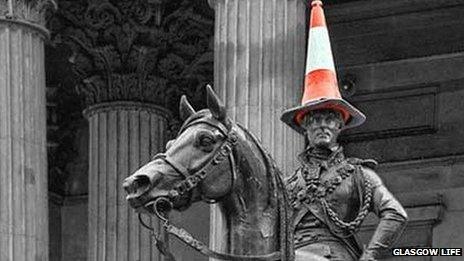Plans to end cone tradition on Glasgow's Wellington statue
- Published

The tradition of placing the traffic cone on the statue dates back more than 30 years
Plans have been lodged to raise the height of the iconic Duke of Wellington statue in Glasgow, in a bid to stop revellers placing traffic cones on it.
The city council wants to raise the plinth as part of a £65,000 project to refurbish the bronze monument.
It said this would end a practice which projected a "depressing image" of Glasgow and would save the £10,000 cost of removing the cone 100 times a year.
Previous attempts to prevent the cone have met widespread local opposition.
The council has already lodged planning permission to carry out the work.
The scheme, which is being supported with £10,000 from Historic Scotland, would see a new granite-clad concrete base of 86cm (34in) added to the memorial to raise its overall height.
'Unfortunate impression'
Restoration work would also be carried out and the missing sabre on the statue replaced.
In its business case, the council states: "For more than 30 years the Wellington monument has been defaced by traffic cones which regularly appear of the head of the horse or rider (and sometimes both) after the revelries of the weekend.
"This depressing image of Glasgow has sadly featured in posters and postcards depicting the city.
"Ironically, this unfortunate impression of the city has been supported by former Lord Provosts and chief executives and even adopted occasionally by the city marketing bureau."
The document states that the cones issue had been "the subject of numerous complaints from elected officials and the public who find them offensive".
It states the matter is also the "subject of time-consuming correspondence".
It adds: "The cost of removing these cones is conservatively put at £100 a time and the frequency is estimated at around 100 times a year.
"This is an estimated burden to the city council of some £10,000 per annum. This cost is unsustainable in the current economic climate."
The council document states that the problem arises from the monument base being "too low".
It states: "Vandals literally step onto the plinth from the rear and then quickly gain access to the horse and rider."
A spokesman for Glasgow City Council said: "The Duke of Wellington statue is an icon so we are planning to restore the statue, replace the missing sabre and increase the height of the plinth the statue sits on.
'Proud icon'
"Paint on the statue is peeling, causing corrosion to the ironwork and hastening water damage. The planned improvement works would return the statue to an icon the city can be proud of.
"Putting cones on the Duke of Wellington statue may seem harmless but it is an act of vandalism and a fall from the statue could be very harmful.
"We would urge anyone considering putting a cone on the statue to not do so."
Some local people say the cone demonstrates Glaswegians' sense of humour and is as much part of the city as any of the famous buildings or statues.
An online petition has already been launched by Donna Yates and Gavin Doig to "Save Wellington's Cone", as well as Facebook plans for a rally in support of the cone.
The petition states: "The cone on Wellington's head is an iconic part of Glasgow's heritage, and means far more to the people of Glasgow and to visitors than Wellington himself ever has.
"Raising the statue will, in any case, only result in people injuring themselves attempting to put the cone on anyway: does anyone really think that a raised plinth will deter drunk Glaswegians?"
The matter is already being discussed widely on social networking sites.
Writer and comedian Greg Hemphill wrote on his Twitter feed: "Raising the statue is a very sound idea cause if there's one thing every Glaswegian loves it's being told what they can and cannot do."
Adapting a former catchphrase from his Chewin' The Fat show, he added: "Cony No Dae That."
The cone hat image of the Wellington monument has been named by Lonely Planet as one of 10 Scottish inclusions in a list of the top 1,000 sights in the world.
In 2000, the council took down the cone for promotional tourist-related photography but replaced it after an outcry by local people and politicians, external.
The Wellington statue was sculpted by Italian artist Carlo Marochetti and erected in 1844.